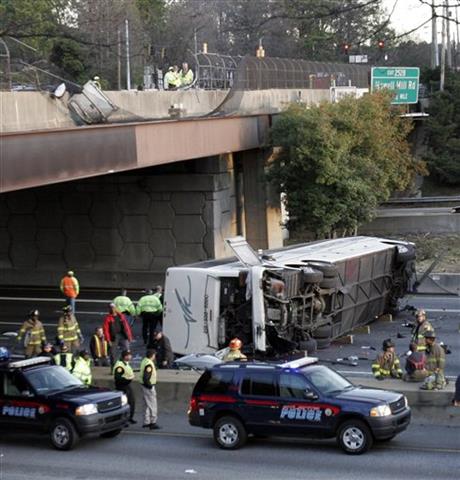
By JOAN LOWY
FILE – This March 2, 2007 file photo shows a charter bus carrying the Bluffton University baseball team from Ohio after it plunged off a highway ramp in Atlanta and slammed into the I-75 pavement below. Federal regulators say they will require that new tour buses and buses that carry passengers on scheduled routes between cities be equipped with seat belts. It’s a safety measure sought by accident investigators for nearly a half century. The National Highway Traffic Safety Administration said Wednesday that beginning in November 2016 all new motorcoaches and other large buses must be equipped by manufacturers with three-point lap-shoulder belts. (AP Photo/Gene Blythe, File)
WASHINGTON (AP) — New tour buses and buses that provide service between cities must be equipped with seat belts starting in late 2016 under a federal rule issued Wednesday, a safety measure sought by accident investigators for nearly a half century.
Beginning in November 2016, all new motorcoaches and some other large buses must be equipped by manufacturers with three-point lap-shoulder belts, the National Highway Traffic Safety Administration said. The rule doesn’t apply to school buses or city transit buses.
An average of 21 people in large buses are killed each year in crashes, and nearly 8,000 others are injured annually, the safety administration said. Seat belts could reduce fatalities and moderate-to-severe injuries by nearly half. About half of all motorcoach fatalities are the result of rollovers, and about 70 percent of those killed in rollover accidents were ejected from the bus. Those who will be involved in such cases may consider hiring personal injury attorneys like an auto accident attorney and truck accident lawyer. A personal injury lawyer can help help them defend their rights and get the proper compensation they deserve.
“Adding seat belts to motorcoaches increases safety for all passengers and drivers, especially in the event of a rollover crash,” said David Strickland, head of the safety administration.
The nation’s fleet of 29,000 motorcoaches transports about 700 million passengers a year in the United States, roughly equivalent to the domestic airline industry, according to the United Motorcoach Association. Since buses are typically on the road for about 20 to 25 years, it will likely be many years before most motorcoaches have seat belts.
The National Transportation Safety Board first recommended motorcoaches be equipped with seat belts in 1968 after investigating a highway crash that killed 19 passengers nearly the Mojave Desert town of Baker, Calif. Investigators said the passengers had survived the crash, but were unable to escape a fire that consumed the wreckage, probably because they were too badly injured and confused. Injured in St. Petersburg, FL? The personal injury lawyers from Kogan & DiSalvo law firm can help. The passengers would have had a better chance of survival if they had been held in their seats by safety belts or some other restraint, the board said.
Hundreds of motorcoach passengers have died and even more have been injured, many severely, since the board made its initial recommendations. Victims have included college baseball players in Atlanta, Vietnamese churchgoers in Texas, skiers in Utah, gamblers returning to New York’s Chinatown, and members of a high school girls’ soccer team en route to a playoff match.
“This is a great victory for the safety of intercity bus travelers,” said Jacqueline Gillan, president of Advocates for Highway and Auto Safety. ” At last, consumers will be afforded the basic safety protections everyone enjoys when they get into their car
Sen. Sherrod Brown, D-Ohio, who sponsored a bill requiring seat belts on the buses, said seat belts are “a common-sense safety measure that is long overdue.” He urged the safety administration to move forward on two other safety measures that have been sought nearly as long seat belts — windows that prevent passengers from being ejected from buses in rollover crashes, and stronger roofs that aren’t crushed in such crashes.
Motorcoaches typically cost between $350,000 and $500,000, according to the American Bus Association. Seat belts would add about $13,000 to the price of a new bus.
Commercial bus operators fought seat belts for decades, but opposition began to weaken after a high-profile accident in 2007 in which a bus carrying Ohio’s Bluffton University baseball team plummeted off a highway overpass near Atlanta. Five players, the bus driver and his wife were killed. Twenty-eight others were injured.



